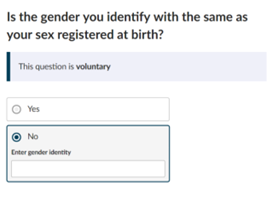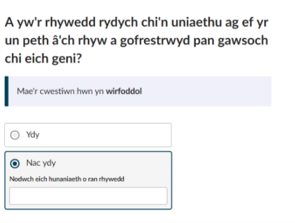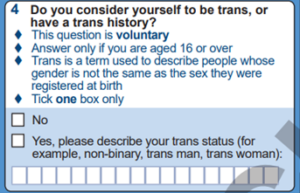Introduction
This is the final report on our review of statistics on gender identity based on data collected as part of the 2021 England and Wales Census.
Learning from new evidence in Scotland’s Census, the Office for National Statistics (ONS) wrote to us on 5 September 2024 to request that the gender identity estimates from Census 2021 should be no longer accredited official statistics and should instead be classified as official statistics in development.
Additionally, ONS has informed us that it will do more to support users in interpreting the census gender identity data and will work with others across the Government Statistical Service (GSS) on developing the gender identity harmonised standard and on sharing guidance for existing survey questions.
We have written to ONS to support its proposal to publish the Census 2021 gender identity statistics in England and Wales as official statistics in development rather than accredited official statistics.
This report sets out the details of this regulatory decision. It also shares our recommendations to ONS on the steps it must take to help users of the gender identity statistics understand their strengths and limitations, and on the development work we consider is required on the GSS gender identity harmonised standard.
The report is structured as follows:
- This section sets out the background to our review, including setting out the timeline of ONS and OSR outputs on this topic.
- The second section sets out an analysis of the concerns about the statistics.
- The third section sets out our regulatory judgement and decision.
- The fourth section sets out future work required by ONS and the GSS.
Note that the term trans is used in this report to describe anyone who stated in the census that their gender identity was different to their sex registered at birth. This includes people who identify as a trans man, trans woman or non-binary, and anyone with another minority gender identity. This terminology aligns with the approach adopted by ONS and the National Records of Scotland (NRS).
Background to the review
A voluntary question on gender identity was asked for the first time in the 2021 England and Wales Census conducted by ONS. This question is also the current GSS harmonised standard (currently in development) for collecting data on gender identity.
The question that people were asked was “Is the gender you identify with the same as your sex registered at birth?”. They had the option of selecting either “Yes” or selecting “No” with the option to write in their gender identity.
The census statistics on gender identity were first released in January 2023 in the statistical bulletin Gender identity, England and Wales: Census 2021.
Following this publication, concerns were raised publicly with ONS and with us about the published estimates of the trans population. As additional data were published, these concerns extended to the relationship between gender identity and proficiency in English. We also received concerns about the level of methodological information published. In response, ONS initiated research work on the topic in April 2023.
Also in April 2023, we commenced a review, based on the principles of the Code of Practice for Statistics, of the census gender identity statistics and ONS’s research findings. The review has considered ONS’s approach to responding to questions raised about the results of the gender identity data. It has not considered gender identity as a concept or the decision to collect data on gender identity in the census.
On 19 June 2023, ONS published an article which provided additional information on the methodology for collecting and processing data on gender identity in Census 2021. We wrote to ONS to welcome the additional information and to share our first emerging findings from our review to help inform its research.
The publication of ONS’s research was postponed twice, having been preannounced for June and then August 2023. ONS published an update on the progress of its research in August 2023.
We published an interim report in October 2023. This set out our expectations for ONS in line with the Code of Practice for Statistics on what we considered was needed to provide assurance on the gender identity census data and the harmonised question. We based the recommendations in the report on evidence that we had gathered on how ONS tested, quality-assured, communicated and engaged with users, both in advance of publishing the results and from the research to date.
In our interim report, we stated that we were satisfied that the overall approach to the 2021 Census complies with the standards of Trustworthiness, Quality and Value in the Code of Practice for Statistics, which is the level of compliance required to achieve accredited official statistics status. But we stated that we would consider the accreditation of this new subset of the Census dataset once ONS had published its research findings. Further, we said that we would publish a final report with our findings after we had reviewed, and engaged with users on, the full set of research.
What has happened since the interim report was published?
At the time of writing our interim report, ONS was focusing on developing a comprehensive package of research on gender identity to explain to users what can and cannot be done with the gender identity census data. It told us that it had chosen to delay publishing its findings until it could be more confident in the conclusions it was drawing. We recommended that ONS set out a timeline for when it would complete its research; in response, ONS decided to instead publish the work it had already done.
Given the amount of time that passed since ONS initiated the research in April 2023, users questioned the justification of the publication delays given that the research amounts to six pages of content, much of which repeats text or data from OSR’s review or signposts to previous material. The report also does not reflect the four outputs that had been preannounced by ONS, which is what users were expecting (Annex A, timeline). ONS did not acknowledge the change in research output. This approach had the potential to damage trust and confidence in the research.
We have confidence that those working on the data and research have done so diligently and in line with the Code. However, we feel this work could have been led with more openness, transparency and direction.
ONS published its research report, Quality of Census 2021 gender identity data, in November 2023. The report covers the background to the question, respondent error, relationships with other characteristics, comparability with other sources and engagement with users of the data. The publication of this research report demonstrates that ONS has sought to take action to respond to user demand for more information to support use of the data. This effort has included releasing additional data tables and engaging with over 20 organisations, including government departments, local authorities, academia and the non-profit and commercial sectors, to understand their needs for the data and supporting information.
The additional data tables published alongside the Quality of Census 2021 gender identity data report are useful for understanding the nature of responses and the intersectionality with other characteristics. These include data on:
- the proportions of the estimated trans population within each local authority who provided a write-in response (GI01: Census 2021 gender identity, proxy indicators of uncertainty for local authorities)
- distribution across categories for the estimated trans population and additionally the distribution based only on those who provided a write-in response to the question (GI02: Census 2021 gender identity, individual characteristics by gender identity)
- distributions for household characteristics for the estimated trans population in households and additionally the distribution based only on those who provided a write-in response to the question (GI03: Census 2021 gender identity, household characteristics by gender identity)
- the coding index for the gender identity question (GI04: Census 2021 gender identity write-ins)
- counts and percentages for sex by proficiency in English by gender identity (GI05: CT21_0186 – Sex by proficiency in English by gender identity)
- proportions of the estimated trans population by age and country of birth – UK or non-UK (GI06: Census 2021 gender identity by country of birth)
Additionally, in November 2023, ONS updated its methodology document, which presents known quality information affecting sexual orientation and gender identity data: sexual orientation and gender identity quality information for Census 2021. This document includes a link to the quality report noted above.
On 27 June 2024, National Records of Scotland (NRS) published the Scotland’s Census 2022 data for sexual orientation and trans status or history. Alongside this statistical publication, NRS published a separate quality assurance document for the variables included in the statistical release.
The voluntary question asked in Scotland to those 16 years or older was “Do you consider yourself to be trans, or have a trans history?”. People were asked to tick “No” or “Yes”. People who ticked “Yes” were asked to describe their trans status (for example, non-binary, trans man, trans woman).
The voluntary question asked in the Scotland Census was different to the voluntary question asked in the England and Wales Census, which was “Is the gender you identify with the same as your sex registered at birth?”. Other differences between the censuses included the following:
- The Scotland question included a prompt for people to describe their trans status or history and gave examples of non-binary, trans man and trans woman, in that order. The England and Wales question did not include any examples of gender identities for the prompt.
- The Scotland Census included a brief definition of trans on the questionnaire. The England and Wales Census did not include a definition.
- The question in Scotland was asked directly after a question on sex on the census form in Scotland, while it was asked later in the census form in England and Wales.
Our approach
As well as reviewing ONS’s research, we carried out stakeholder engagement. The views of those who use, or would like to use, the gender identity statistics helped to direct our research. We engaged with a range of stakeholders, users and potential users of the data. Our engagement included speaking to some of the stakeholders who had raised concerns with us and ONS during the research for our interim report, as well as several organisations which had not previously contributed to the review.
Our engagement highlighted a wide variety of views and strength of opinion. These stakeholder views helped us to gain a better understanding of the extent to which ONS’s post-publication research has responded to user concerns and helped users to better understand and use the data. It was also helpful to hear stakeholders’ views on the gender identity question and the potential for its further development as the harmonised standard.
This report has been reviewed and approved by the Authority’s Regulation Committee, which oversees the work of OSR.
Back to top


